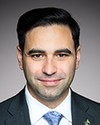Thank you.
I'm Tony Bernardo. I'm the executive director of the Canadian Shooting Sports Association. I'm a member of the Canadian firearms advisory committee, from Anne McLellan to Steven Blaney continuously and a member of Anne McLellan's firearms experts technical committee.
I'd like to speak about the removal of the Governor in Council ability to declare a firearm to be non-restricted. The removal of the RCMP mistake eraser, the section of the Firearms Act that currently allows the minister to override a bad classification decision, implies that the RCMP has never made a mistake. It also implies the Government of Canada has never made a mistake. Our community wishes this were indeed true, but the RCMP has a long history of making mistakes regarding classifications.
One of the firearms currently being prohibited in Bill C-71 is the subject of a long history of mistakes made by the experts in firearms classifications. The CZ 858 rifle was initially brought into Canada in 2004. The RCMP experts gave it a classification of non-restricted. In 2014, after almost 10,000 rifles had been sold as non-restricted firearms, the RCMP changed their mind. They reclassified all the rifles sold between 2007 and 2014 as prohibited 12-3 converted fully automatic rifles, despite the rifles being absolutely mechanically identical to the 2004 to 2007 examples.
After the public safety minister of the previous administration corrected this regrettable action by the RCMP using the mistake eraser, Bill C-71 seeks to eliminate that they did not relent to the will of their political masters, but incorrectly interpreted an import identical to the models reclassified as non-restricted to be a new model because it had an image of a Greek warrior engraved on the receiver cover, a non-restricted part, similar to putting a racing stripe on a car. Mechanically, they were identical.
Not once, not twice, but three times the RCMP classified the same gun three different ways. When you thought it couldn't get worse, we now have the same firearm being classified as 12-11. According to the news release by Public Safety Canada, the new legislation proposes to “Ensure the impartial, professional, accurate and consistent classification of firearms as either 'non-restricted' 'restricted' or 'prohibited' - by restoring a system in which Parliament defines the classes but entrusts experts in the Royal Canadian Mounted Police (RCMP) to classify firearms, without political influence”.
The RCMP experts said they were 12-3 prohibited, but now they aren't. Now they're 12-11. Since the guns didn't change, we have to wonder what the new classification is about. The answer to this is self-evident. To retain the firearms as 12-3 would mean they would have to be confiscated immediately, and it's politically unpopular to confiscate lawfully owned property. To confiscate lawfully owned property would require compensation be paid to the tune of $14.6 million. To grandfather existing owners into 12-3 would then mean that the new additions would be able to buy other 12-3s, and that wasn't popular either.
If the firearms were grandfathered in 12-3, existing owners would not be permitted to shoot them. That would also be politically unpopular, so the question is answered. Every single one of these points is based upon its politics. The CZ 858 is no longer a 12-3 like the RCMP experts claimed, nor the non-restricted firearm that the RCMP experts claimed before, but it's now a 12-11, as proclaimed by the current government. Since the guns didn't change, and the RCMP didn't change, it seems obvious the changes to 12-11 are solely politically based, the very issue Public Safety Canada claims Bill C-71 is intended to prevent.
If these firearms are as dangerous as is claimed, how come people have been allowed to keep them for decades? There are somewhere around 10,000 firearms. If they're that dangerous, why are the owners being allowed to grandfather them?
To close on this subject, why was the ability to restrict or prohibit firearms not removed? The minister could wield the power, but only in one direction, only to make it more restrictive, not to make it less so.
“Government should base their policies on facts, not make up facts based on policy. Without evidence, government makes arbitrary decisions that have the potential to negatively affect the daily lives of Canadians.” That's a quote from the Liberal Party policy document used in the last election.
There is no proof that anything is wrong with authorizations to transport. There have been no incidents. Why are we now seeing these particular authorizations to transport hatcheted like they are?
Why can't people take the firearm to a gun store to sell it? They can bring one home from the gun store, so it's not the distance that's the problem. They can go from Cornwall to Kenora with 24 hours of non-stop driving, shoot in a match for a week, and then drive back. That's legal, but they can't take it across the road to the gunsmith.
In closing, I'd like to invite all of you to the parliamentary day at the range on June 5. It is a non-partisan event. There are no politics. There are no cameras. There's just a whole lot of information, and you get to try these firearms that you are currently prohibiting and compare them to other ones that are out there. We'd love to have you come. We have lots of one-on-one coaches. It's a very safe event. This is our seventh year, and it's open to all parties.
Thank you.




